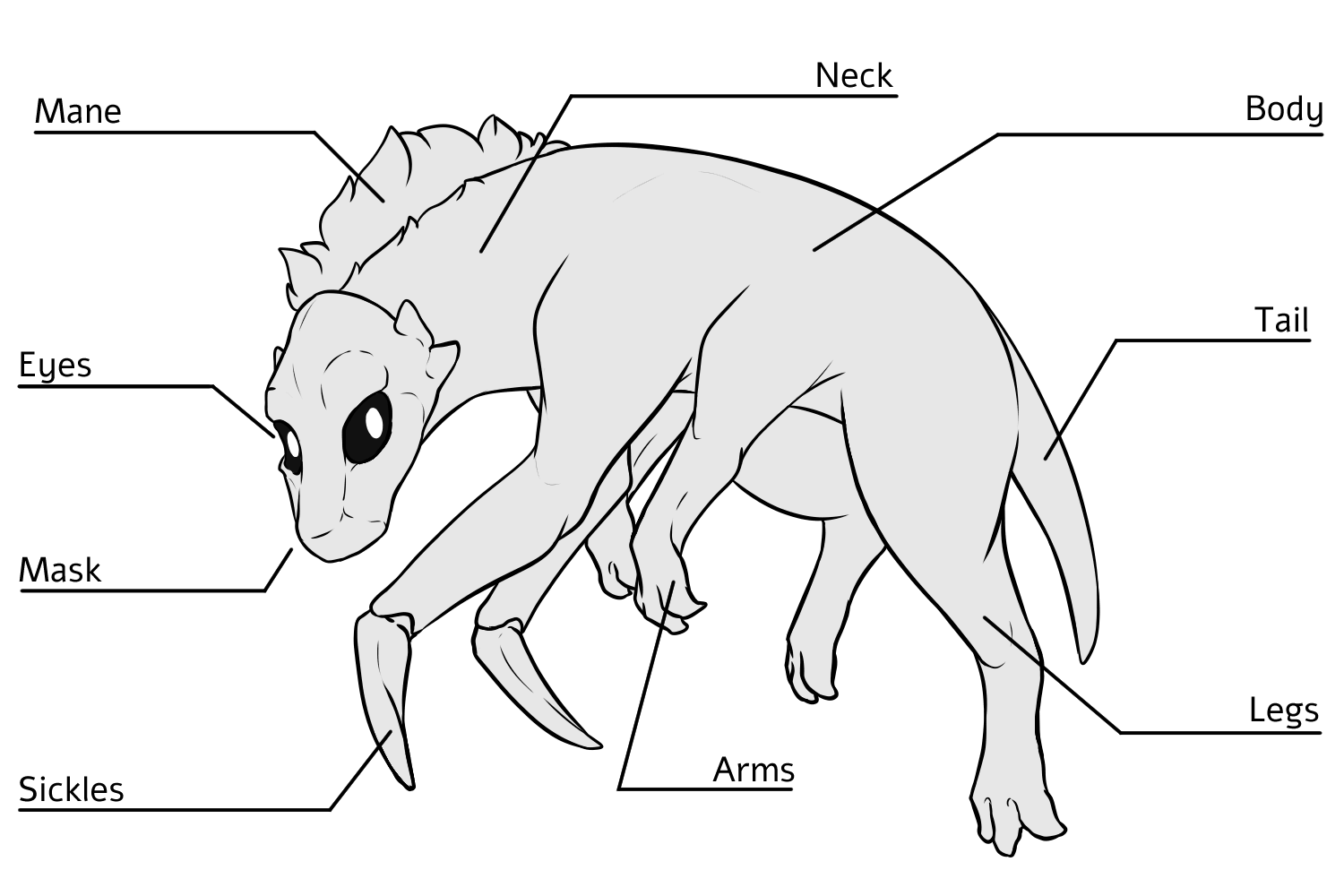
Standard Creopan
Despite being known as the 'standard' for creopan, the standard variant of creos were not the first to be discovered. It is even debatable as to if they're as numerous as the originally discovered bone yard variant. Regardless, the standard variant is now considered the origin point of other variants. The standard body plan that the others stem from, mask, with six limbs, a smooth body and a tail.

Masks
Despite the term used, a creo's mask is the majority of their head. The material of a creo's mask is a organic rock like substance that also makes up their sickles. Any 'openings' within is impenetrable by light and look to be dark 'holes' beneath the mask's structure. The mask can come in all sorts of shapes and colours, but will not typically have a lower jaw.

Eyes
The 'eyes' of a creopan are actually a collection of highly reflective 'pigment' that indicate their visual sensors. Located within the sockets of their masks, the eyes are a solid colour with 'gradients' due to the varying amount of lights being reflected. They can willingly change the shape of these eyes but each eye will always remain one continuous shape.
While a creo sees primarily through their main eyes, their entire mask also acts as a rudimentary visual organ able to sense light. While it doesn't provide much visual information, it does allow them a near 360 awareness of light and dark around them.

Neck / Mane
Creos have a neck similar to horses. A decent length neck and with a mane down the back. Creo manes are not just limited down the back however, and can grow on anywhere else on their necks. Manes can come in various lengths and colours and can be a mix of lengths as well. This results in a varied range of manes in pattern, colours and styles.

Sickles / Front Legs
Named after the shape they end in, a creo's first set of limbs are known as their sickle legs. The sickles are made of the same material as their masks and is used in four legged movement as well as communication. Their sickles can range in length and have some variability in shape. Despite being known as 'legs', creos will sometimes use their sickles as limited hands, as well as tucking them beneath themselves to run on their hind legs like a raptor.
Hands / Middle Arms
A creo's second pair of limbs. While a stape (creopan young) uses all six limbs to traverse or roll about, a standard creo quickly outgrows their middle arms. While some creos might have longer or shorter arms, larger or smaller hands, by adulthood, the shorter arms no longer bear weight or used for walking. Their arms remain their primary way for them to grab and manipulate objects around them through out their entire lives however, regardless of age.
Hind Legs
The final pair of limbs for a creo. Creo legs can either end in paws or with stubby toes. Used as their primary method of locomotion, be it on twos or more. It is advised not to get kicked by a creo, especially not the larger individuals.

Tails
A standard creo has a short to medium length tail that is smooth and usually tapered. The longest a creo's tail would be is the same length as the their bodies. It should be noted that many variants of creos can be identified by their tails, due to it being a common difference between the variants.
Size
Creopan come in a variety of sizes. A standard creo can range from the size of a small cat to the largest dog species. Some variants are typically larger or smaller than the standard creo, and more information can be found in the more in depth page here.
Traits
Creopan can look different from the usual standard creo, either due to traits that they have or being a variant of the species. Do note that no trait would ever cover or take over the stripe of mane down the back of their necks that is the minimum coverage a creo must have. Further information on such can be found on their respective pages.